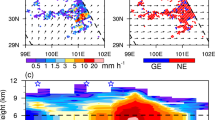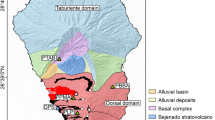Abstract
IN the radio echo sounding method for measuring the thickness of polar ice masses, the sounder transmits regular pulses each containing several cycles of VHF radio waves into the ice. Usually the glacier bed is rough so the echo is a distorted version of the transmitted pulse: it is lengthened and the amplitude and phase of the carrier wave vary within its length (Fig. 1). The echoes also vary rapidly with horizontal displacement of the radio echo sounder1, and this variation is known as the spatial fading pattern.
This is a preview of subscription content, access via your institution
Access options
Subscribe to this journal
Receive 51 print issues and online access
$199.00 per year
only $3.90 per issue
Buy this article
- Purchase on Springer Link
- Instant access to full article PDF
Prices may be subject to local taxes which are calculated during checkout
Similar content being viewed by others
References
Bailey, J. T., Evans, S., and Robin, G. de Q., Nature, 204, 420 (1964).
Harrison, C., thesis, Univ. of Cambridge (1972).
Berry, M. V., J. Phys. A. Gen. Phys., 5, 272 (1972).
Nye, J. F., Kyte, R. G., and Threlfall, D. C., J. Glaciology (in the press).
Evans, S., and Smith, B. M. E., J. Sci. Inst. (J. of Phys., E), 2, 131 (1969).
Robin, G. de Q., Evans, S., and Bailey, J. T., Phil. Trans. Roy. Soc., A, 265, 437 (1969).
Author information
Authors and Affiliations
Rights and permissions
About this article
Cite this article
WALFORD, M. Glacier Movement measured with a Radio Echo Technique. Nature 239, 93–95 (1972). https://doi.org/10.1038/239093a0
Received:
Issue Date:
DOI: https://doi.org/10.1038/239093a0
This article is cited by
-
Rapid disintegration of the Wordie Ice Shelf in response to atmospheric warming
Nature (1991)
-
Bottom sliding of a glacier measured from the surface
Nature (1975)
-
Measuring the Change in Thickness of the Antarctic Ice Sheet
Nature Physical Science (1972)
Comments
By submitting a comment you agree to abide by our Terms and Community Guidelines. If you find something abusive or that does not comply with our terms or guidelines please flag it as inappropriate.



